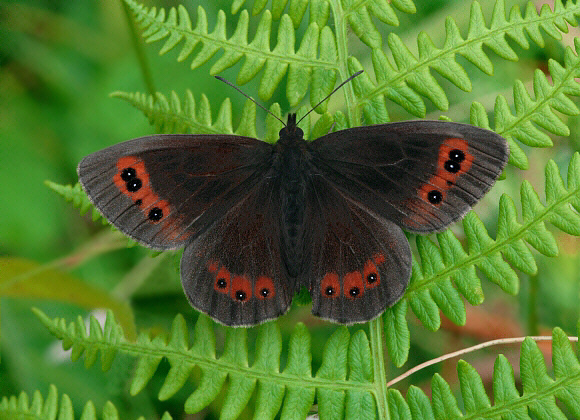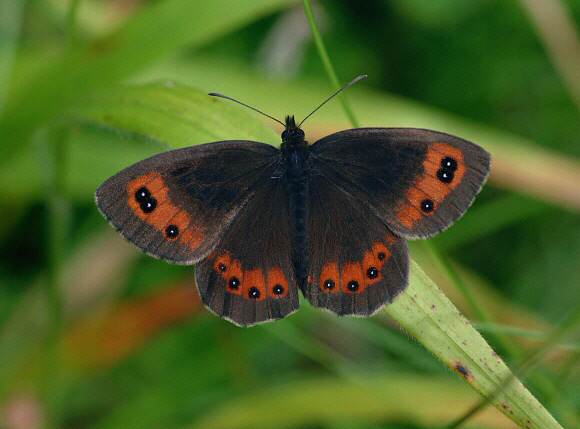 Erebia aethiops, male, Arnside Knott, Cumbria – Adrian Hoskins
Erebia aethiops, male, Arnside Knott, Cumbria – Adrian Hoskins
Introduction
The Scotch Argus is widely distributed in central and eastern Europe, but is absent from Ireland, Spain, Portugal, western France, peninsular Italy, Scandinavia and the Mediterranean region. Its range extends to northern Turkey and across temperate Asia to western Siberia.
The sexes are virtually identical on the upperside – males have a large patch of dark androconial scales on the forewings, but this can only be seen under certain lighting conditions. The underside hindwings of the male are dark reddish brown, with a broad grey post median band. In females the ground colour beneath is a paler earthy brown, banded with olive.
In mainland Europe there are several other Erebia species which closely resemble aethiops. These include ligea, euryale, medusa and triaria. The various species can be distinguished by examining the number and configuration of the ocelli. The patterns on the undersides also differ. A good field guide is essential for determination.
There are no similar species in Britain, although aethiops could be confused in flight with the Ringlet Aphantopus hyperantus. The Arran Brown Erebia ligea is similar to aethiops but has prominent white markings on the underside hindwings. It was allegedly found in Scotland in the 19th century, but all records are regarded as highly dubious – unfortunately early entomologists often made false claims about the butterflies they collected, habitually importing European specimens and claiming they had captured them in Britain.
 Erebia aethiops, male, Arnside Knott, Cumbria – Adrian Hoskins
Erebia aethiops, male, Arnside Knott, Cumbria – Adrian Hoskins
Habitats
The Scotch Argus forms large colonies often numbering dozens, hundreds or sometimes thousands of individuals in the best habitats.
In Britain it is confined almost exclusively to Scotland. In England it formerly occurred at several sites in Cumbria, Yorkshire, Northumberland and County Durham; and probably also in Lancashire, but is now only found only at 2 sites – Arnside Knott in Cumbria, and Smardale Gill in Yorkshire.
Unlike most members of the genus Erebia, the Scotch Argus is not a montane species. It occurs at elevations below 500m, in warm, sheltered and damp situations where the grasses Molinea caerulea or Sesleria caerulea grow in tall, lush, dense tussocks.
In Scotland the butterfly is commonly found in valley bottoms, and at damp grassland / woodland mosaic habitats, particularly those along riverbanks, or around the edges of lochs. Colonies also occur on warmer, more sheltered areas of lightly wooded moorland, on scrubby damp heaths and hillsides on the islands of the Inner Hebrides, as well as on the mainland.
The 2 sites in northern England are very different in nature – at Arnside Knott it occurs on limestone where rough grassland is sheltered by woodland; and at Smardale Gill it is abundant along a disused railway line running through a limestone grassland / woodland mosaic.
Lifecycle
The butterflies emerge in late July and fly throughout August.
The eggs are attached singly to grass blades and stems, at the base of tussocks of purple moor grass Molinea caerulea in Scotland, or blue moor grass Sesleria caerulea in Cumbria and Yorkshire. A much wider range of grasses is used in mainland Europe including Bromus, Brachypodium, Poa, Festuca and Dactylis. At some sites in Europe eggs are laid on the sedge Carex sempervirens.
The eggs are spherical, finely ridged, and straw coloured. After a few days they develop a pattern of dark purplish speckles, finally turning grey just before the larva hatches.
The larvae hatch in late August, nibbling a circular groove around the upper egg shell, creating a lid through which they exit. They then eat the remaining shell which contains vital nutrients, and having finished their meal rest for a while before starting to eat tender young grass blades. They only feed for a few weeks before entering into hibernation at the base of grass tussocks. There they remain until April when they awaken to resume feeding. When fully grown they are dull umber in colour, with dark green stripes and speckles along the back and sides. Like most Satyrine larvae they are crepuscular by nature, feeding in the early evening and again at dawn.
The fully grown larva leaves the foodplant in mid June, and wanders a short distance to pupate in a small silk-lined cavity excavated amongst mosses. The pupa is pale brown, with the thorax, wing cases and eye covers pale purplish in colour.
 Erebia aethiops, male, Arnside Knott, Cumbria – Adrian Hoskins
Erebia aethiops, male, Arnside Knott, Cumbria – Adrian Hoskins
Adult behaviour
The butterflies dislike hot weather, and at such times sit motionless on bushes or amongst grasses, with their wings firmly closed. They are most active in warm sunny conditions when the males can be seen gently bobbing about just above the tall grasses, fluttering and weaving tirelessly in search of potential mates. If there is a slight drop in temperature, or cloud temporarily obscures the sun, they settle to bask on bracken, bramble leaves or other low foliage; but quickly disappear deep into grass tussocks if it becomes too cool, or if there is any threat of rain.
Copulation takes place in late morning amongst grasses, and lasts for about an hour. Females are quiescent until mated, after which they can be seen flying in and out amongst grass tussocks in hot sunshine to oviposit.
Both sexes nectar avidly at almost any available flowers including thistles, knapweeds, bramble, hawkweeds, heather and meadowsweet; fluttering from flower to flower, and usually holding the wings half-open while feeding.
